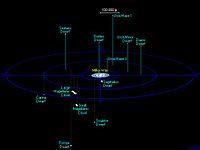
Photo from wikipedia
The co-evolution between central supermassive black holes (BHs), their host galaxies, and dark matter haloes is still a matter of intense debate. Present theoretical models suffer from large uncertainties and… Click to show full abstract
The co-evolution between central supermassive black holes (BHs), their host galaxies, and dark matter haloes is still a matter of intense debate. Present theoretical models suffer from large uncertainties and degeneracies, for example, between the fraction of accreting sources and their characteristic accretion rate. In recent work, we showed that active galactic nuclei (AGNs) clustering represents a powerful tool to break degeneracies when analysed in terms of mean BH mass, and that AGN bias at fixed stellar mass is largely independent of most of the input parameters, such as the AGN duty cycle and the mean scaling between BH mass and host galaxy stellar mass. In this paper, we take advantage of our improved semi-empirical methodology and recent clustering data derived from large AGN samples at z ∼ 1.2, demonstrate that the AGN bias as a function of host galaxy stellar mass is a crucial diagnostic of the BH–galaxy connection, and is highly dependent on the scatter around the BH mass–galaxy mass scaling relation and on the relative fraction of satellite and central active BHs. Current data at z ∼ 1.2 favour relatively high values of AGN in satellites, pointing to a major role of disc instabilities in triggering AGN, unless a high minimum host halo mass is assumed. The data are not decisive on the magnitude/covariance of the BH–galaxy scatter at z ∼ 1.2 and intermediate host masses $M_\mathrm{star} \lesssim 10^{11} \, \mathrm{M}_\mathrm{star}$. However, future surveys like Euclid/LSST will be pivotal in shedding light on the BH–galaxy co-evolution.
Journal Title: Monthly Notices of the Royal Astronomical Society
Year Published: 2021
Link to full text (if available)
Share on Social Media: Sign Up to like & get
recommendations!